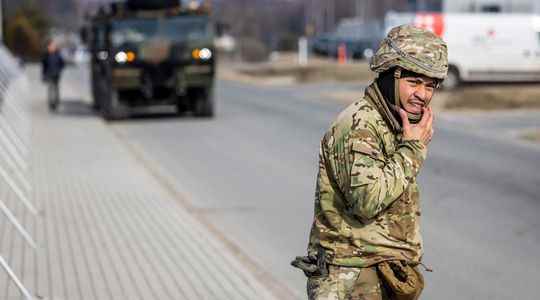They are a few hundred, barely out of their teens in Kentucky or Nevada, to have landed in Poland in early February. Three weeks before the start of the Russian invasion of Ukraine, members of the legendary 82nd Airborne Division crossed the Atlantic to defend Europe, like their ancestors in 1944.
“The arrival of the 82nd American division carries an extremely strong symbol. These are the soldiers who participated in the landing on the Normandy beaches, they are the ones who secured Kabul airport, explains Amélie Zima, NATO specialist associated with the Thucydide Center of the Panthéon-Assas University. Politically, for the Poles, it is an important presence.”
Nearly eighty years after the end of the Second World War, the United States is strengthening its presence in Europe in the light of the Russian threat, when it already has 80,000 soldiers on the continent. A strong symbol of Western solidarity, this presence highlights Europe’s military weakness. “Europe realizes that a war on its continent is possible and that it only has a very limited defense system, asks Georgina Wright, director of the Europe program at the Institut Montaigne. to Russia without the Americans, because too many European countries continue to rely on NATO.”
The “fantastic backwardness” of the European Union
Chance of the calendar, Thursday February 24, while the Russian army launched its massive bombing campaign on all of Ukraine, the European Union (EU) finally finalized the Eurodrone contract, an ambitious European defense program which must provide drones common to several Member States on the horizon… 2029. “Europe is beginning to understand the new post-Cold War world, judge Pierre Vimont, Emmanuel Macron’s special representative for Russia. But it has fallen behind fantastically that she must now catch up by working twice as hard!”
The most blatant illustration is the German case: an economic giant, the most populous country in the European Union, Germany remains a military dwarf. With less than 200,000 soldiers, the Bundeswehr is a smaller army than that of Ukraine, for example. “The army that I lead is more or less dry”, had also reacted the chief of staff in a mind-blowing message posted on social networks last Thursday, in the midst of the Russian invasion.
Weakened by thirty years of military disengagement and total confidence in the American ally, Germany is embarking on a revolution: Chancellor Olaf Scholz announced on Sunday a fund of 100 billion euros to modernize its army and annual military expenditure than 2% of its GDP. Unprecedented. “German security policy is going through a radical change, a ‘new era’ to use the words of Olaf Scholz, believes Amélie Zima. The invasion of Ukraine has caused a real shock in the country.”
Sending arms to Kiev, a revolution in Brussels
But Europe must also manage the short term. In an exceptional decision, Sunday February 27, Brussels undertook to supply 450 million euros worth of weapons to Ukraine, in the midst of a fight against Russia. Since the start of the crisis, Vladimir Putin has made no secret of his threats to Europeans: he notably warned Sweden and Finland of “military consequences” if these countries joined NATO.
“Ukraine unfortunately finds itself alone against Russia, but this will not be the case for EU countries, underlines Jean-Dominique Giuliani, president of the Robert Schuman Foundation. Article 42-7 of the European treaties foresees that if Russia touches an EU member, it will find itself at war with all the European countries, and it is not certain that Putin has understood this well…”
To prevent the threat and deter Russian troops, Europe deployed its soldiers on its eastern flank, from Poland to Romania. Above the Baltic countries, French, Spanish or Danish planes are now patrolling. And for good reason, Latvia, Lithuania and Estonia remain devoid of aviation…
